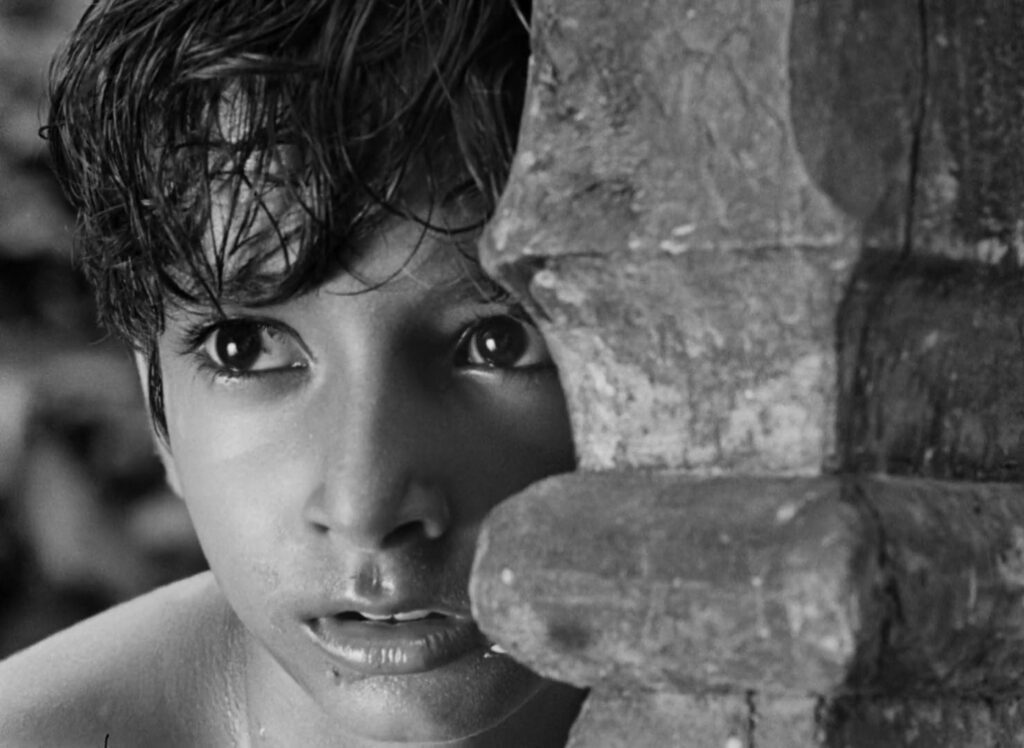
Pather Panchali
1955, directed by Satyajit Ray
Pather Panchali opens with the moneylender Mrs. Mukherjee performing a religious devotion on her terrace. She catches sight of Durga taking a fallen guava from her orchard and turns to yell after the little girl: “Look at that! That girl won’t leave any fruit on the trees!” The contrast between her pious prayer and her rant at the impoverished child may look like a stock portrayal of hypocrisy, but it also lays out the terms of the film’s argument, setting up a dialectic between the spiritual and the material. This same contrast reappears much later when a beggar comes by, singing “What do I care for worldly wealth?” immediately before asking for alms.
The meanings of “spirit” and “matter” here are as broad and secular as they are in Bresson’s films, where the spiritual encompasses everything that makes life worth living, including simple joys, wonders, and the bonds that join people together. When we look at it this way, the duality is totally pervasive and systematic in Pather Panchali. Mrs. Mukherjee and the beggar turn from one pole to the other on a dime, but those two pale in comparison to Apu’s schoolteacher Prasanna, who jumps back and forth between matter and spirit in a bravura display of ambidexterity. While dictating a poem on “the mighty mountain Prasravan” to his pupils, he simultaneously operates a grocery store, measuring out rice and exchanging money with customers. A couple of village elders come by, and he toggles fluidly between conversing cheerfully about a theater troupe and scolding the students.
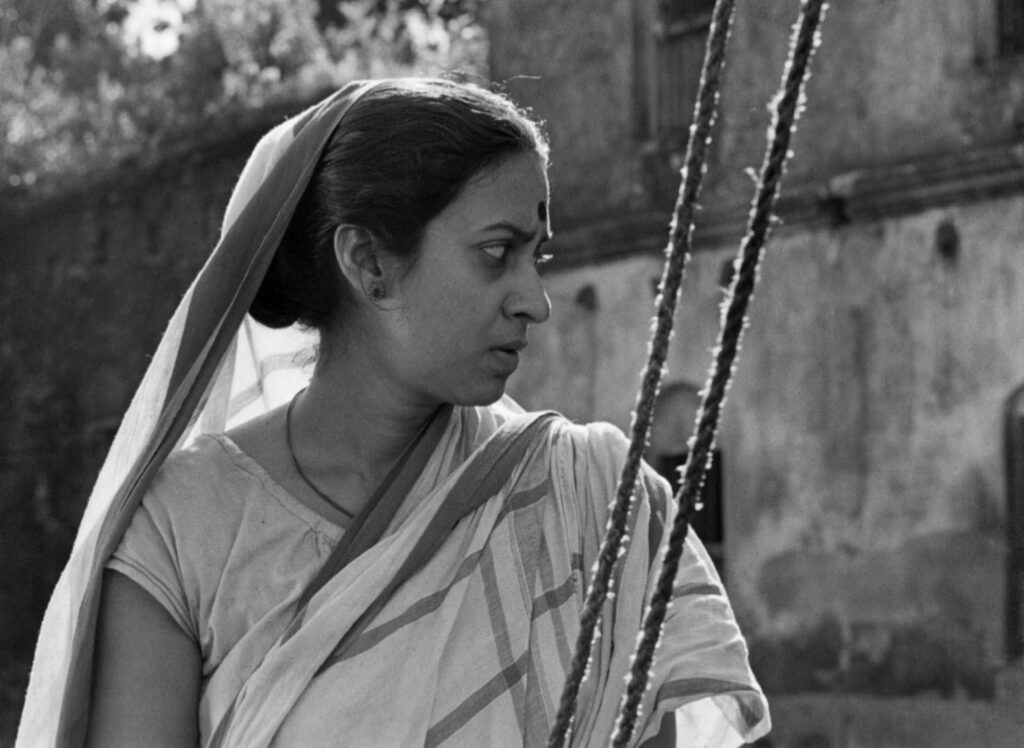
The father of Durga and Apu, Harihar Roy, is a young Brahmin who has fallen on hard times. He makes a meager living as a priest while aspiring to become a respectable playwright. In both respects he lives in a world of spirit. He also works as a rent collector, but the job doesn’t seem to suit his trusting temperament, and he waits months for his salary. When Apu writes a homework composition, the father encourages the son to insert a ghost in the story. Harihar’s wife Sarbajaya is as firmly grounded in the material world as he is in the spiritual. Her concerns are for the family’s food, shelter, clothing, income, health, and social reputation. She’s the family’s disciplinarian, and she’s so harsh toward the elderly Auntie Indir that she drives the old woman out of the house three times.
Ironically it’s the father who supplies the family’s material needs and the mother who supplies their spiritual needs, showing the children tenderness and letting them play and explore outside. Rather than reducing the parents to one-sided portraits, the movie allows them a measure of complexity. Harihar and Sarbajaya don’t merely personify the polarities of matter and spirit – they illustrate the separation between those two ideals. Supporting characters like the village elders or Sarbajaya’s compassionate best friend, Nilmoni’s wife, are also arrayed along this axis, which should not be misconstrued as an axis of good and bad; they are all flawed yet sympathetic, like real human beings.
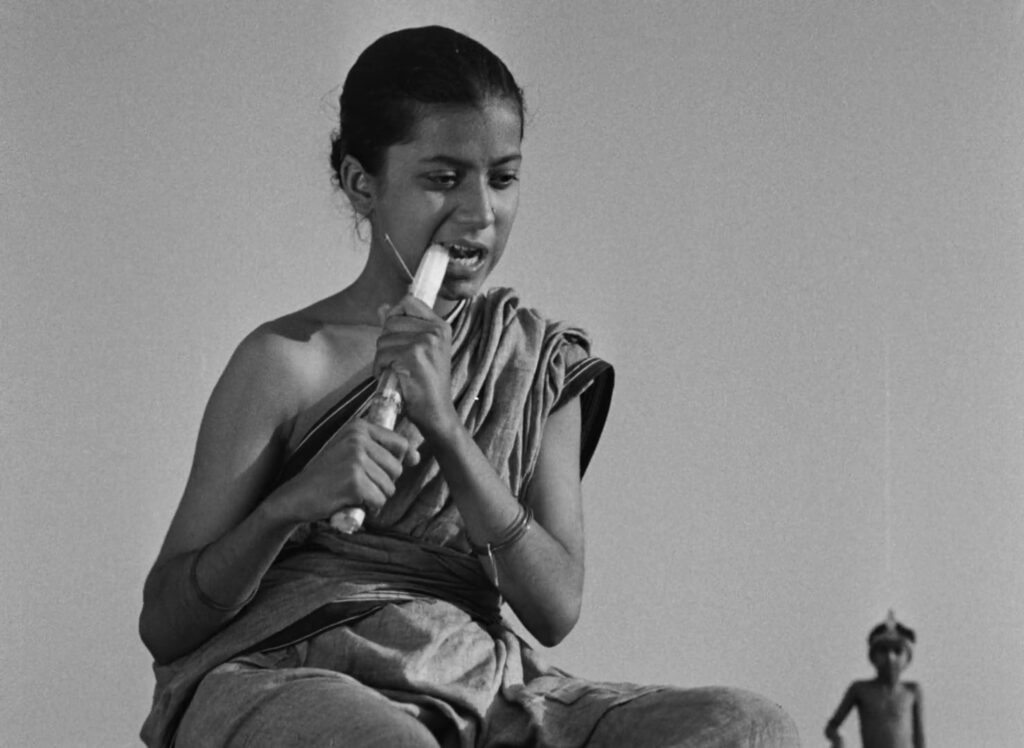
In this sense the wisdom of Pather Panchali lies in the two children, who make no distinction between matter and spirit. Whatever sustains them physically is at the same time a source of joy. When they follow the sweets peddler, their pursuit turns into a magical jaunt with animals and lively music, shown upside-down on the surface of a pond. A guava represents property to Mrs. Mukherjee and nourishment to Sarbajaya, but for Durga it’s the spice of life, bringing a smile to her or to Auntie. Durga takes particular delight in giving water to the kittens, so that it’s hardly a chore for her. To an adult, a train or telegraph wires are eminently practical, but for Apu and Durga they’re cause for wonder. By distinguishing the children from the adults along these lines, Pather Panchali implicitly argues not only that the distinction between matter and spirit is false, but that it’s a learned error, a misunderstanding that creeps into our lives as we grow up.
The difference between Durga and Apu defines a second axis. It’s not quite enough to say that he is born within the story and that she dies – in fact we don’t see either the birth or the death. Apu appears fifteen minutes in as a newborn, but his arrival is heralded with greater effect six minutes later when Durga reaches under his blanket to open his eyelid, waking him up and introducing him as a character. To put it properly, Apu and Durga represent not life and death per se, but a “coming-to-life” and a “going-from-life”. This distinction is important because, while Durga embodies the same sense of wonder that we see in Apu, and which separates them from the mother’s materialism and the father’s religiosity, nevertheless in a few incidents we witness her childhood wisdom beginning to leave her, as if she begins to slip away from life before she actually dies.
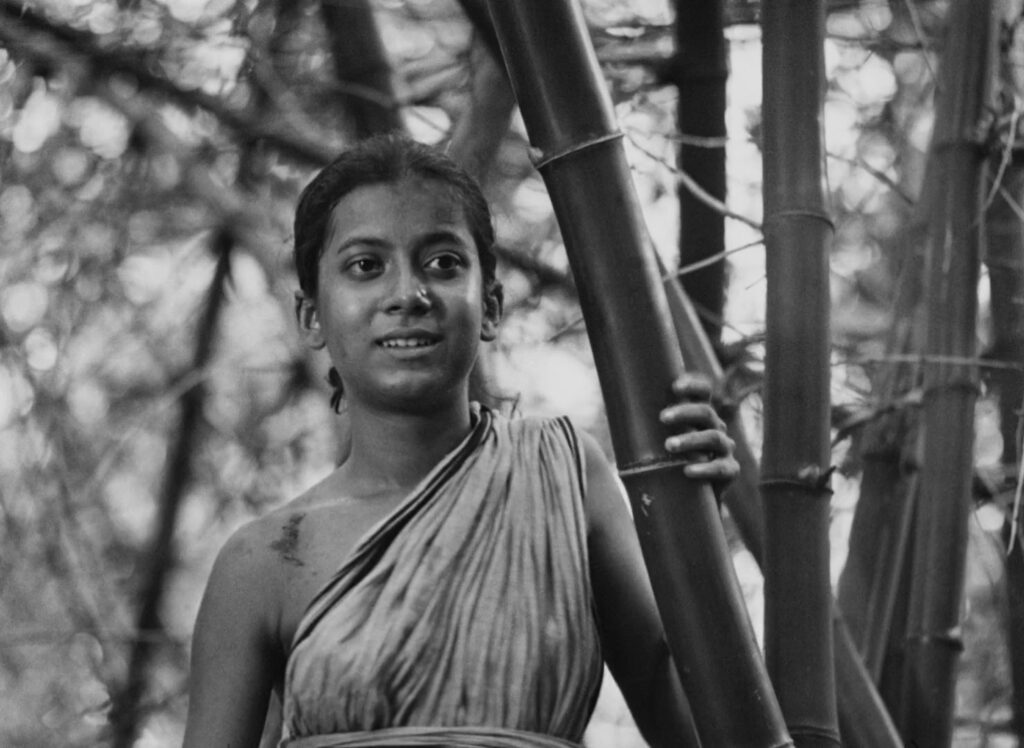
Near the end of the first hour, Durga and her friends gather outside to cook khichdi, taking delight in putting the ingredients together: “Rice, lentils, potatoes, eggplant, cumin, chilies, bay leaves, oil…” but as soon as Durga realizes that Tepi forgot to bring salt, the friendly gathering erupts into a quarrel. Now food is no longer a simple joy for Durga; it’s become a problem, as it is for the adults who see its material properties separate from its spiritual benefits. Later when she finds that Apu has raided her toy box to make a shiny foil crown, she chases her brother in anger. The innocent pleasure of toys has turned into possessiveness. At her friend’s bridal ceremony Durga’s expression betrays a hint of envy, materialized in the two strands of hair that droop below her eye like streaming tears. Toward the end, as the family prepares to leave their home, Apu discovers the stolen necklace Durga had hidden in a cup. A spider crawls away, underscoring the horror Apu must feel as he grasps that his sister had coveted this jewelry not for its potential enjoyment, like the guavas, but out of spite. Wishing to preserve the memory of Durga’s innocence, he throws the necklace into a pond. It’s the last we see of Durga, and the image of the algae closing over the necklace is the reverse of Apu’s eyelid opening earlier.
The four members of the Roy family therefore describe a matrix that extends beyond the family into larger society. Auntie Indir is unique in this schema, crossing all the lines of the matrix. Combining the qualities of Apu and Durga, she constantly comes and goes, and she also crosses the line between matter and spirit. The necessities of life are simple pleasures for her – a guava, a shawl, or the shelter of home – and she likewise seems to enjoy helping with the laundry, grinding spices, rocking baby Apu, and telling the children fairy tales. For all this she receives little appreciation. When she leaves the third time, she’s placed in symmetry with a dog from Sarbajaya’s point of view, but the movie values her more than it can say directly. While she’s alive we can only infer that she holds the family together, but her death, two-thirds of the way through the film, confirms it, as everything unravels afterward. Immediately after Auntie Indir’s funeral, two things happen in parallel: the children run to see a traveling bioscope showing off the far-away landmarks of India; and Harihar prepares to leave the village. Both foreshadow the family’s exit at the end, minus Durga who falls ill and dies.
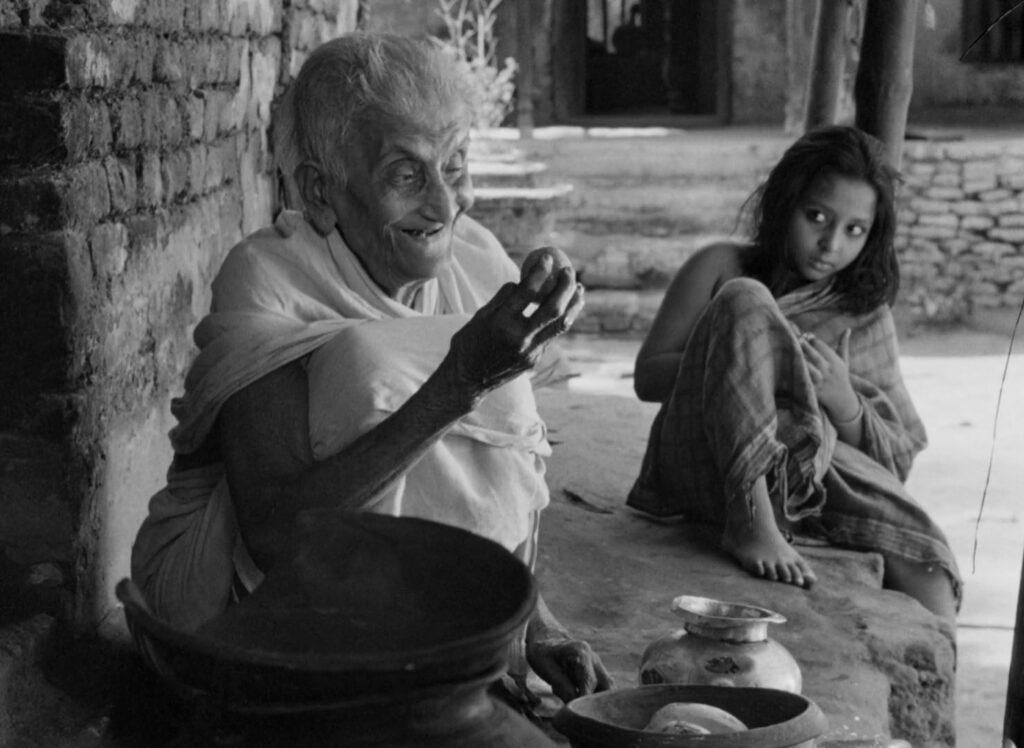
The ending of Pather Panchali may not seem strange to present-day viewers who are well aware that it leads to two sequels, Aparajito and The World of Apu, but the original audience was not aware of that. For the film to stand on its own we must try to recapture the original sense of this ending, which holds none of the eternal feeling that movies of this caliber usually reach for. Nothing is resolved; there’s no promise; the family just leaves – that’s all. Their movement on the oxcart is horizontal, more typical for a movie’s opening when forward narrative flow is needed. Strangest of all, the family faces backward.
From these observations we can begin to appreciate what makes Pather Panchali so extraordinary. Its first two thirds are full of incident, but there’s little real narrative until the final third. The first part may be full of hardships, but in retrospect there’s something wonderful about all the life that transpires while Auntie Indir is alive. We can readily understand why the family would look back toward their village with sorrow. What’s important here is how universal the experience was at the time. In the context of both the Partition of India and widespread urbanization, almost anyone in West Bengal would have related to the experience of being uprooted, which the ending of Pather Panchali describes so powerfully. The film is often compared to Italian neorealism, which strongly influenced Satyajit Ray, but it’s the ending in particular that would have connected audiences to reality with a bang.
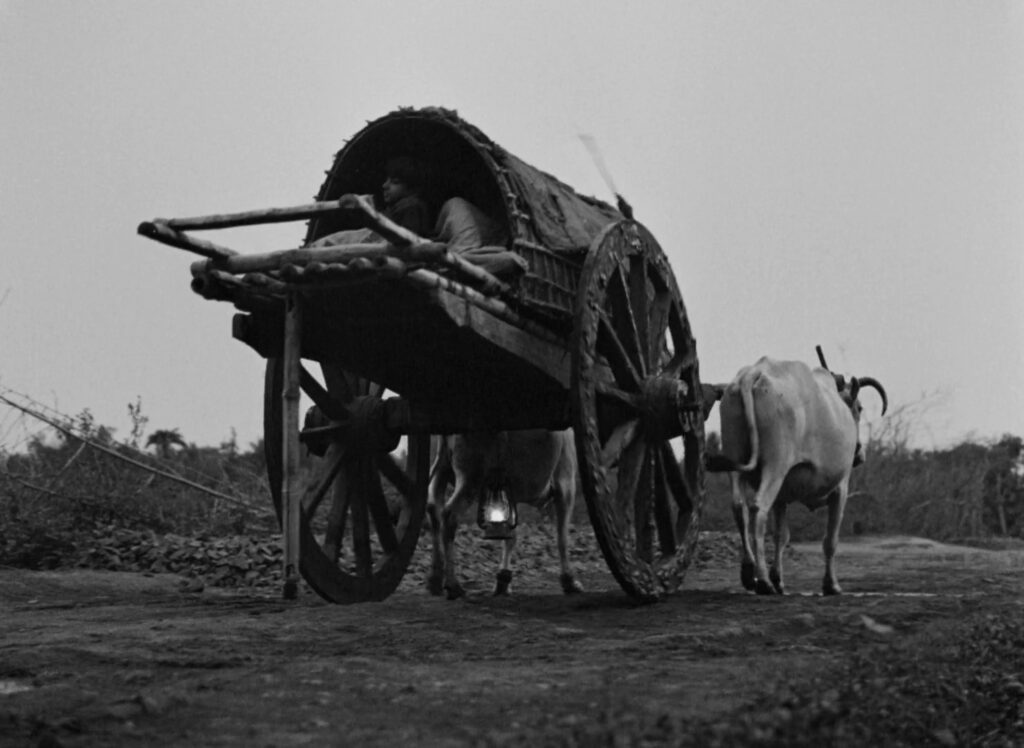
In all of this we can make a strong inference about the film’s political stance. Its distinction between “matter” and “spirit” assumes nothing supernatural; the spiritual here is entirely earthly, subsisting in experience and relationships. The dialectical nature of their opposition, which finds synthesis in the children and in Auntie Indir, points toward socialism. The unnatural segregation of matter from spirit produces the twin devils of capitalism and religion, which lead life astray. The seeds of decline are present before Auntie Indir dies, but once she’s gone it’s as if the life drains out of the whole family. The band playing “It’s a Long Way to Tipperary” is one sign of this lifelessness, incidentally linking it to colonialism.
Right before the family leaves at the end, Mrs. Mukherjee comes by with a gift of mangos. Her attitude is contrite, and she admits she’s never given the family anything before. Reflecting on her past conflict with Durga and Sarbajaya she says, “Rotting away in one place year after year does no one any good. It makes a person petty and mean. That’s what it’s done to me.” On one hand this dialogue humanizes her; she’s capable of self-reflection – but what’s striking about it is how contrary it is to the spirit of the ending, which mourns the family’s uprooting. We should understand that her problem is not “rotting away in one place”. In the next line she reveals her true nature: “Perhaps I’ll go on a pilgrimage to Chandranath.” Reversing her about-face at the opening she turns back to pure spirituality, as if that would make anything better.
CONNECTIONS:
Early Summer – Period of stasis at the beginning that depicts everyday family life
Tokyo Story – Characters arranged in a matrix of significance with a reversal in the parents’ alignment; emotionally charged scene near the end
The Music Room – Spider at the end signifying decay or corruption